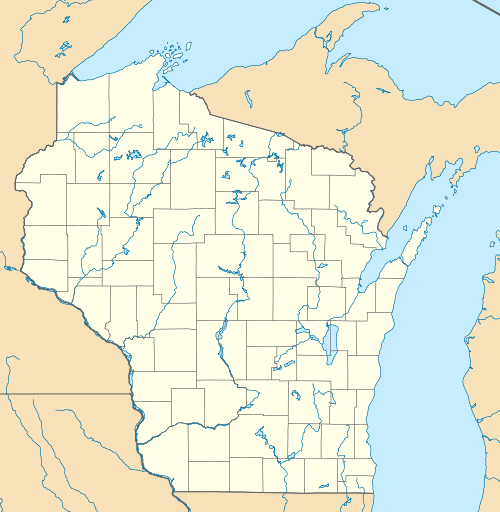Little White Schoolhouse
|
Little White Schoolhouse | |
|
The Little White Schoolhouse in 2013 | |
  | |
| Location | 303 Blackburn Street, Ripon, Wisconsin |
|---|---|
| Coordinates | 43°50′38″N 88°50′11″W / 43.84389°N 88.83639°WCoordinates: 43°50′38″N 88°50′11″W / 43.84389°N 88.83639°W |
| Built | 1854 |
| NRHP Reference # | 73000079 |
| Significant dates | |
| Added to NRHP | August 14, 1973[1] |
| Designated NHL | May 30, 1974[2] |
The Republican Schoolhouse, also known as Little White Schoolhouse or Birthplace of the Republican Party, in Ripon, Wisconsin is a National Historic Landmark. Now located at the southeast corner of Blackburn and Blossom Streets in Ripon, it has been moved several times.[3]
History


Construction
The structure was built in its original location in 1853 as a school building for the young town of Ripon, Wisconsin. It was championed as part of a wider education initiative by a New York transplant, Alvan Bovay.[4] Bovay used his position in founding the school to further involve himself in politics, becoming a founder of the Republican Party, which formed during a meeting at the schoolhouse (see Politics).
The town quickly outgrew the small building, and built a larger brick building to replace it. The old building was sold to Wisconsin governor George Peck, for use as a home.
By the early twentieth century, it had fallen into disuse, and was in danger of being demolished. Due to its historical significance, effort was put into saving the building and marketing it (see Preservation).
Politics
In 1854, opposition grew to the proposed Kansas-Nebraska Bill. The bill was championed by the dominant Democratic Party, and the opposition was split among several smaller parties, including the Whig Party, the Free Soil Party, and some internal Democratic Party splintering. In Ripon, Bovay, who had gotten the schoolhouse built, lead the opposition, and canvassed support among opposition members of all the local parties. He called a meeting on March 20. The Whig and Free Soil parties dissolved themselves in favor of forming a new, united party to be called "Republican," with some Democrats also defecting from their local party branch to join the new party. With publicity from the New York Tribune, word of the party spread, other local chapters and state-level parties started forming by July or earlier, and a national party was formed by 1856.[4]
Preservation
By the early twentieth century, it had fallen into disuse, and was in danger of being demolished.
Local civic and historical organizations, considering its local and national historical significance, raised funds to save it. The building was refurbished, and moved to the campus of Ripon College. Later, it was moved twice more to other locations on campus.
Its fourth and final move, in 1951, was to its present location.
Twenty-two years later, it was recognized it as a historic site by the United States National Park Service, which declared it a National Historic Landmark in 1974.[2][3] From 2005 to 2007, the house underwent a renovation.
References
- ↑ National Park Service (2007-01-23). "National Register Information System". National Register of Historic Places. National Park Service.
- 1 2 "Little White House". National Historic Landmark summary listing. National Park Service. Retrieved 2008-01-02.
- 1 2 Levy, Benjamin (November 8, 1973). "National Register of Historic Places Inventory-Nomination: Little White Schoolhouse / "Birthplace of the Republican Party"" (pdf). National Park Service. and Accompanying 3 photos, exterior, from 1972 and 1973. (1.05 MB)
- 1 2 "History". Little White Schoolhouse.
External links
| Wikimedia Commons has media related to Little White Schoolhouse. |
- Official website
- Historic American Buildings Survey (HABS) No. WI-15, "Republican Schoolhouse, Second & Elm Streets, Ripon, Fond du Lac County, WI", 1 photo, 2 measured drawings, 3 data pages, supplemental material
